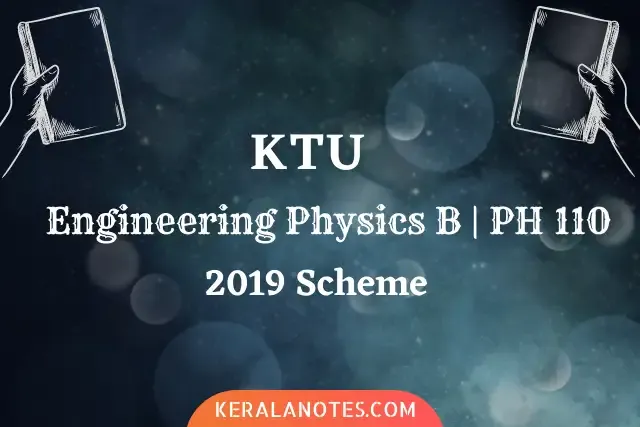KTU PHY 110 Engineering Physics B (For Non-Circuit Branches) module wise Notes, syllabus, question papers and Textbook for free based on the latest 2019 scheme. These notes are very helpful to students of all engineering branches(CSE, Mech, Civil, ECE, EEE). These notes are prepared by students and teachers. This course provides a sound foundation in the fundamental Physics concepts that are relevant to the study of Electrical and Electronic Engineering. In particular, this course takes into account some of the core fundamental physics concepts from Classical Mechanics and from Electricity and Magnetism.
| Board | KTU |
| Scheme | 2019 New Scheme |
| Year | First Year |
| Semester | S1 & S2 |
| Subject | PH 110 | Engineering Physics-B Notes |
| Credit | 4 Credit |
| Category | KTU S1 & S2 |
KTU S1/S2 Engineering Physics B | PH110 | Notes (2019 Scheme)
Module 1
Module 1 - Syllabus
Oscillations and Waves
Harmonic oscillations, Damped harmonic motion-Derivation of differential equation and its solution, Over damped, Critically damped and Under damped Cases, Quality factor-Expression, Forced oscillations-Differential Equation-Derivation of expressions for amplitude and phase of forced oscillations, Amplitude Resonance-Expression for Resonant frequency, Quality factor and Sharpness of Resonance, Electrical analogy of mechanical oscillators
Wave motion- Derivation of the one-dimensional wave equation and its solution, Three-dimensional wave equation and its solution (no derivation), Distinction between transverse and longitudinal waves, Transverse vibration in a stretched string, Statement of laws of vibration
Module 1 - Notes
Module 1 Engineering Physics B | PH 110 PDF Notes
Module 2
Module 2 - Syllabus
Wave Optics
Interference of light-Principle of superposition of waves, Theory of thin films - Cosine law (Reflected system), Derivation of the conditions of constructive and destructive interference, Interference due to wedge-shaped films -Determination of thickness and test for optical planeness, Newton’s rings - Measurement of wavelength and refractive index, Antireflection coatings
Diffraction of light, Fresnel and Fraunhofer classes of diffraction, Diffraction grating-Grating equation, Rayleigh criterion for the limit of resolution, Resolving and Dispersive power of a grating with expression (no derivation)
Module 2 - Notes
Module 2 Engineering Physics B | PH 110 PDF Notes
Module 3
Module 3 - Syllabus
Quantum Mechanics & Nanotechnology
Introduction for the need of Quantum mechanics, Wave nature of Particles, Uncertainty principle, Applications-Absence of electrons inside a nucleus and Natural line broadening mechanism, Formulation of time-dependent and independent Schrodinger wave equations-Physical meaning of wave function, particle in a one-dimensional box- Derivation for the normalised wave function and energy eigenvalues, Quantum Mechanical Tunnelling (Qualitative)
Introduction to nanoscience and technology, Increase in surface to volume ratio for nanomaterials, Quantum confinement in one dimension, two dimension and three dimension-Nano sheets, Nanowires and Quantum dots, Properties of nanomaterials-mechanical, electrical and optical, Applications of nanotechnology (qualitative ideas)
Module 3 - Notes
Module 3 Engineering Physics B | PH 110 PDF Notes
Module 4
Module 4 - Syllabus
Acoustics & Ultrasonics
Acoustics, Classification of sound-Musical sound-Noise, Characteristics of Musical Sounds-Pitch or frequency-Loudness or Intensity-Measurement of Intensity level-Decibel-Quality or timbre, Absorption coefficient, Reverberation-Reverberation time-Significance- Sabine’s formula (no derivation), Factors affecting architectural acoustics and their remedies
Ultrasonics-Production- Magnetostriction effect and Piezoelectric effect, Magnetostriction oscillator and Piezoelectric oscillator –Working, Detection of ultrasonic waves - Thermal and Piezoelectricmethods, Ultrasonic diffractometer- Expression for the velocity of ultrasonic waves in a liquid, Applications of ultrasonic waves -SONAR, NDT and Medical
Module 4 - Notes
Module 4 Engineering Physics B | PH 110 PDF Notes
Module 5
Module 5 - Syllabus
Laser and Fibre optics
Properties of laser, Absorption and emission of radiation, Spontaneous and stimulated emission, Einstein’s coefficients (no derivation), Population inversion, Metastable states, basic components of laser, Active medium, Pumping mechanism, Optical resonant cavity, working principle, Construction and working of Ruby laser and Helium-neon laser, Construction and working of semiconductor laser(Qualitative), Applications of laser, Holography, Difference between hologram and photograph, Recording of hologram and reconstruction of image, Applications
Optic fibre-Principle of propagation of light, Types of the fibres-Step index and Graded index fibres, Numerical aperture –Derivation, Fibre optic communication system (block diagram), Industrial, Medical and Technological applications, Fibre optic sensors-Intensity Modulated and Phase modulated sensors
Module 5 - Notes
Module 5 Engineering Physics B | PH 110 PDF Notes
KTU S1 & S2 Related Links
| KTU S1 & S2 Study Materials | Click Here |
| KTU S1 & S2 Study Notes | Click Here |
| KTU S1 & S2 Syllabus | Click Here |
| KTU S1 & S2 Reference Textbook | Click Here |
| KTU S1 & S2 Previous Year Solved Question Papers | Click Here |
Other Related Links
| PHT 100 - Engineering Physics A | Click Here |
| PHT 110 - Engineering Physics B | Click Here |
| MAT 101 - Linear Algebra and Calculus | Click Here |
| EST 100 - Engineering Mechanics | Click Here |
| EST 120 - Basics of Civil Engineering | Click Here |
| EST 120 - Basics of Mechanical Engineering | Click Here |
| HUT 101 - Life Skills | Click Here |
| CYT 100 - Engineering Chemistry | Click Here |
| EST 110 - Engineering Graphics | Click Here |
| MAT 102 - Vector Calculus, Differential Equations and Transforms | Click Here |
| EST 102 - Programming in C | Click Here |
| EST 130 - Basics of Electrical Engineering | Click Here |
| EST 130 - Basics of Electronics Engineering | Click Here |
| HUT 102 - Professional Communication | Click Here |






